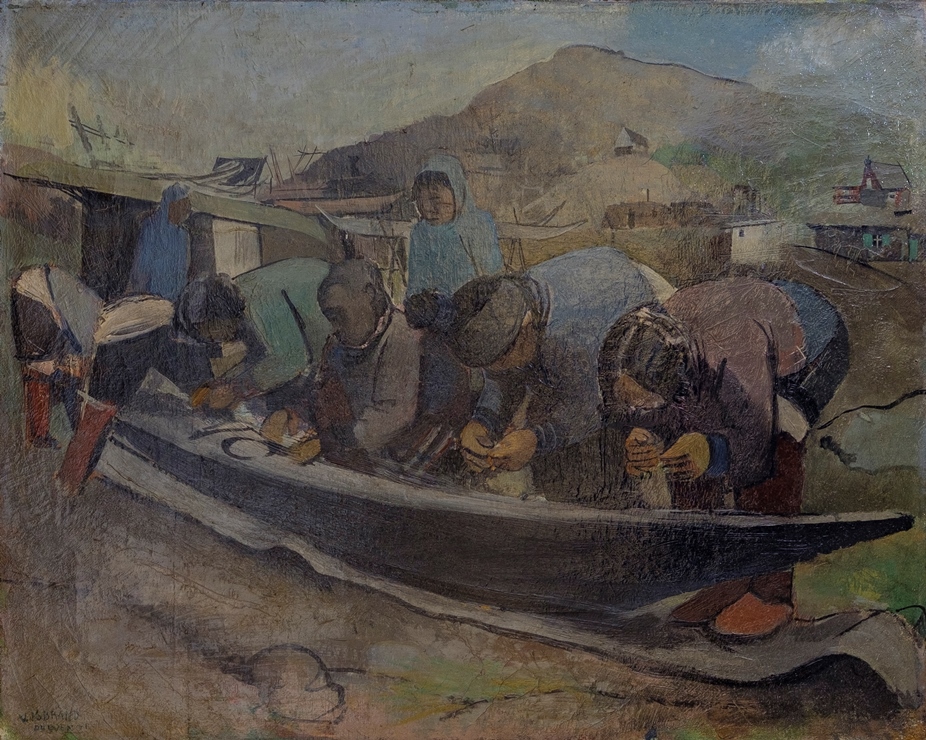At Nuuk Art Museum the painting “Prøven 35” by the Danish artist Victor Isbrand is on display. It is almost as if the kayak emerges from the painting. There is an atmosphere of deep concentration around the kayak in the painting. The women working on the kayak are on one hand the focal point of the painting but on the other hand they are not; their faces are not visible. Only two faces can be seen, belonging to a woman and a boy. Their faces are solemn; the woman because she seems deeply concentrated on her task, while the boy waits impatiently. The subdued colours of the painting seem to emphasize the women’s deep concentration.
Victor Isbrand became successful at an early age, being only 20 when he completed his studies at The Danish Royal Academy in Copenhagen. His early success lead him to travel the world at a young age, including trips to Java, Thailand, Malaysia, China and Japan. In the summer of 1935 he travelled to Greenland with his wife and fellow artist Oda Isbrand. On board the ship ”Hans Egede” they travelled for three months, going as far north as to Upernavik and Prøven. The sketches they made during their trip became the basis of several paintings interpreting the Greenlandic landscape and way of life, which where exhibited in Copenhagen the following year.[1] The painting in Nuuk Art Museum’s collection must be from this exhibition.
Victor Isbrand has said about their stay in Greenland, that it offered them a good opportunity to study and paint “the primitive life” at the settlements, as he put it. Isbrand was not only fascinated by the inuit but by indigenous peoples in general. In an interview from 1922 about his travels to Java, he stated:
“Yes, I wanted to go to Java to see Natural people.
-What is that?
– That is what we are not, we have been bloated by what we think is culture.
(…) The people [in Java] were so whole, in their beauty and in their ways of being.”[2]
Several other artists have had this fascination; in a Danish context there is Sonja Ferlov Mancoba (1911 – 1984) who was inspired by African art. Mancoba introduced here Danish colleagaues, like Ejler Bille (1910 – 2004), to African art. The Danish artists viewed the art of the foreign cultures as immediate and true. Both Mancoba, Bille and Victor Isbrand, were part of the Danish Modernism inspired by European art movements like cubism, surrealism and expressionism. Influential artists like Paul Gauguin (1848 – 1903) and Pablo Picasso (1881 – 1973) were inspired by foreign cultures; Gauguin from a trip to Tahiti and Picasso by African figurines and masks. In a Danish-Greenlandic context another prominent figure in this context is Aage Gitz-Johansen (1897 – 1977) who was deeply inspired by Greenlandic nature, animal life and people.
Isbrand and his works inspired by Greenland is in continuation of this tradition; studies of a foreign culture, romanticizing the view on Greenland and the Greenlandic people.
This article was written by Laila Lund Altinbas. 2019.
[1] A number of the works by Oda Isbrand made on this trip can be found in the collection of Nunatta Katersugaasivia Allagaateqarfialu/Greenland National Museum and Archive.
[2] Quote from Bent Irve and others: Victor Isbrand – Maler og pædagog, Forlaget Per Kofod 1987, p. 166, my own translation.

